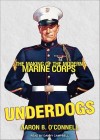Underdogs: The Making of the Modern Marine Corps
Written by: Aaron B. O’Connell,
Harvard University Press, 2012,
ISBN 9780674058279, 400pp
Reviewed by: Tristan Moss
The United States (US) Marine Corps occupies an exalted place in American society, as the vast array of popular films, books and television series attests. As the fighting arm of the ‘light on the hill’, the Marine Corps promotes US values as much as the Marine himself embodies them. Such is the power of the Corps that it is easy to assume that this has always been the case. In his cultural history, Underdogs: The Making of the Modern Marine Corps, Aaron B. O’Connell explores the transformation of the Marine Corps from a ‘tiny, unpopular and institutionally disadvantaged’ service into a paragon of fighting power and moral strength. The book covers the period between the US entry into the Second World War and the War in Vietnam; it was during this time that the Marines built their public image, defended their very existence and finally positioned themselves as an indispensible ‘fire brigade’ for US interests throughout the world.
The period in question saw the Marine Corps perfect a system of public relations and lobbying that was the envy of the other services. O’Connell argues that this system of engagement with the public and with lawmakers was the product of a siege mentality among Marines, who felt that their service was perpetually under threat of disbandment. Consequently, the Marines actively constructed a dual image based on tradition and values. On the one hand the Corps presented itself as embodying aggressive masculinity, typified by its motto ‘first to fight’. As the Cold War began in earnest, the Corps also rejected the more technological focus of the other services, preferring to emphasise a more romantic image of the fighting man and his rifle. At the same time, the Marine Corps sold itself directly to American homes, positioning the individual Marine as a husband, father or brother. Reinforced and refined as the Cold War progressed, this dual image contributed to the cultural power of the Corps by allowing it to not only present itself as the defender of America as a nation, but also as an upholder of American values.
Underdogs is a detailed and probing book, and does not hold back from examining the darker side of the hard-fighting Marine Corps identity. The chapter on alcoholism, domestic violence and the abuse of new recruits during training is woven into the story alongside the more romantic images of the Corps. The way in which the Corps dealt with these problems, while at the same time seeking to affirm its place as the upholder of US martial spirit in the face of fears that the country was becoming ‘soft’ at a crucial stage in the Cold War, is a fascinating insight into the competing pressures of a society facing both an existential threat and in the throes of modernisation.
Alongside the Corps’ engagement with the public, Underdogs explores the more storied history of civil-military relations involving the Marines. In particular, O’Connell provides a very detailed dissection of the often-underhanded Marine Corps fight against military reorganisation during the 1950s and the lobbying of Congress by the so-called ‘Chowder Society’ of Marine officers in Washington. The creation of an informal network of congressmen that crossed partisan lines to support the Marine cause was testament to the growing power of the Corps. The willingness of the service to provide post-retirement promotions to former Marines (Joe McCarthy went from captain to lieutenant colonel after leaving the Corps) is also proof of the lengths to which the Corps was prepared to go to court favour.
At times O’Connell becomes bogged down in narrative detail. Moreover, despite being a study that rests to a great extent on a comparison with the other services, too often this comparison is not fully explored. O’Connell tends perhaps to give the Marines too much credit without exploring their place as the smallest service, buying into the ‘narrative of Marine exceptionalism’ a little too much. The discussion of the Corps’ embracing of expeditionary warfare during the 1960s, for instance, is presented as an example of the forward planning and an unfettered Marine thinking in the face of the other services’ obsession with high end and nuclear warfare. The degree to which the Marines sought to prepare for and engage in this type of warfare, but could not, is not discussed by O’Connell, nor is the possibility that the Marines had the freedom to explore niche capabilities precisely because the other services had ensured US proficiency in nuclear and high-intensity warfare.
Overall, Underdogs is a model for other studies exploring how and why services construct their own image. O’Connell, paraphrasing Mary A. Renda and Edward Said, notes that ‘successful military institutions “require stories as well as guns”’. Underdogs is a detailed and important account of the construction of the US Marine Corps story.

